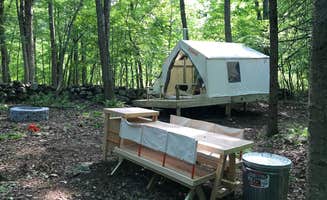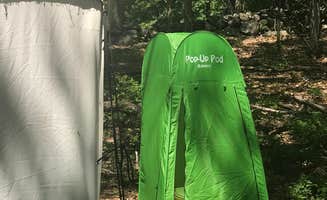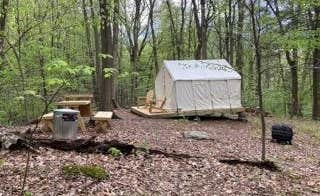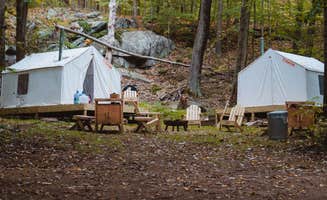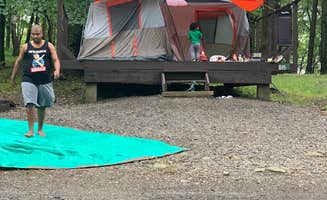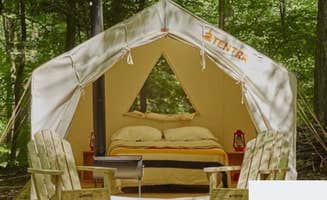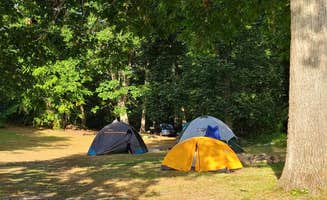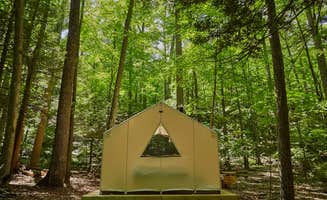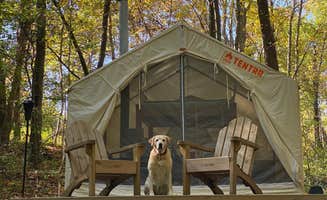Camping options near Lake Mohegan, New York sit at elevations between 200-1,300 feet in the Hudson Highlands region, where summer temperatures typically range from 60-85°F. Most campgrounds in this area remain open from mid-April through October, though several offer year-round access with reduced services during winter months.
What to do
Hiking the Appalachian Trail access points: Several campgrounds near Lake Mohegan connect to segments of the Appalachian Trail. At The Stephen & Betsy Corman AMC Harriman Outdoor Center, campers note that "Great trails to hike for novices looking to branch out but not too large that you'll be lost forever." The trail sections are well-marked with white blazes and vary in difficulty.
Swimming in lakes with beach access: Beaver Pond Campground offers swimming in Welch Lake with a sandy beach maintained throughout summer. "A stones throw from NYC this beautiful area combines Lake Welch and Harriman State Park. This camp ground is laid back away from the busy activity of the big city. The beach is secured with lifeguards and shower and bathroom facilities are available," reports one visitor to Beaver Pond Campground.
Rock scrambling with primitive camping: For experienced hikers seeking more challenging terrain, primitive camping sites along the Suffern-Bear Mountain trail provide scenic overlooks. "Suffern-Bear Mountain from Gate Hill Road is a high difficulty 15 mile out and back trail. At one point of the trail is a very difficult, but doable, rock scramble up the side of the mountain. At the top of the scramble is a primitive camping site with amazing views," notes a camper who completed the 2.5-mile hike from the trailhead.
What campers like
Wooden platforms for tents: Many campers appreciate the raised tent platforms available at several campgrounds in the region. At Sebago Cabin Camp, campers can rent rustic cabins or use tent platforms. "These cabins are VERY rustic, four walls, a cot, and a fridge. You still feel like you are 'roughing it' but with the convenience of a fridge," explains one visitor. These platforms keep tents dry even after rainfall.
Proximity to New York City: Many campgrounds in the area serve as quick escapes from urban environments. According to one camper at Yogi Bear's Jellystone Park: "About 30 minutes from sleepy hollow and tarrytown NY and only an hour to central park! Deer running everywhere and surprisingly beautiful and quaint." This accessibility makes these locations popular for weekend trips.
Well-spaced campsites: Unlike some crowded camping areas, several parks offer sites with adequate spacing. "The biggest positive about Beaver Pond is how spread out it was. You definitely feel like you have your own space and are not camping on top of your neighbor," notes one visitor. Sites at most parks can be reserved up to 9 months in advance through the New York State Parks reservation system.
What you should know
Bear activity requires proper preparation: Multiple campgrounds report regular bear sightings and activity, particularly in Harriman State Park. "A quick 40 minutes north of NYC, Harriman State Park has an eclectic little campground called Beaver Pond. 'Welcome to Bear Mountain' grumbles the park ranger as he sits in complete darkness! He is in his ranger hut, checking in the late evening arrivals to the campground... and gives us the run down on bear activity in the area," reports a camper. Most campgrounds require food to be stored in vehicles or provided bear boxes.
Mid-week visits offer significantly different experiences: Campgrounds throughout the region show marked differences between weekday and weekend camping. At Clarence Fahnestock State Park Campground, a camper notes: "Busy Campground on Weekends! Weekends - this park is FULL! Make sure to reserve at least two weeks out. Weekdays? You should be in luck!" This pattern holds true across most camping areas in the region.
Limited cell service at most locations: Cell coverage varies significantly across campgrounds, with many reporting limited or no service. A visitor to Round Pond Recreation Area mentions: "Just a note to other campers with T-Moblie, we did not have any service on the campsite, however just a hop in the car or a quick walk down the mountain for 5G service near the entrance off the main road."
Tips for camping with families
Look for campgrounds with playgrounds: Several family-friendly campgrounds feature dedicated play areas. "We were very impressed with the playground on site!" notes a visitor to West Point FMWR Round Pond Outdoor Recreation Area. Other family-friendly amenities at various parks include basketball courts, shallow swimming areas, and nature centers.
Consider camping at Ward Pound Ridge for safer hiking with children: This reservation offers well-maintained trails appropriate for various skill levels. "The grounds are far too well trimmed, as you can see in one of the videos. There is wide open space and the paths are well paved so kids can have fun riding the bikes or running around. There is also many trails of various difficulty levels to suit everyone," explains one visitor with children.
Check site positioning when booking: Site locations can significantly impact family camping experiences. At Croton Point Park, a visitor warns: "The tent site is after the RV site, so use their LX before you get to site if you can. The site was very loud (dance music) until after 11pm. Quiet time at 10pm. Great site for a party, try to stay away from this end of the site or choose a site away from other bookings if you'd like quiet."
Tips from RVers
Electric options limited but available: Several campgrounds offer electric hookups for RVs, though full hookup sites are less common. At Croton Point Park, "A county park with a mix of w/e (6 sites) and FHU sites plus about a dozen tent sites near a capped dump! The reservation process is a bit wonky. You need to call (no online reservations) and then wait for an e-mail, but the e-mail does not tell you your assigned site; you have to wait until you check in to find out your site."
Prepare for tight clearances: Some campgrounds have limited space for larger rigs. "The FHU sites were back-to-back and although there were trees separating the sites, they were close together," notes an RV camper. Most campgrounds in the region can accommodate rigs up to 30 feet, but larger vehicles may find limited options.
Consider alternate access routes: Many roads leading to campgrounds in the area include winding mountain routes that can be challenging for larger vehicles. RV campers should research routes carefully before arrival, especially when approaching from the north where roads tend to have steeper grades and tighter turns.


